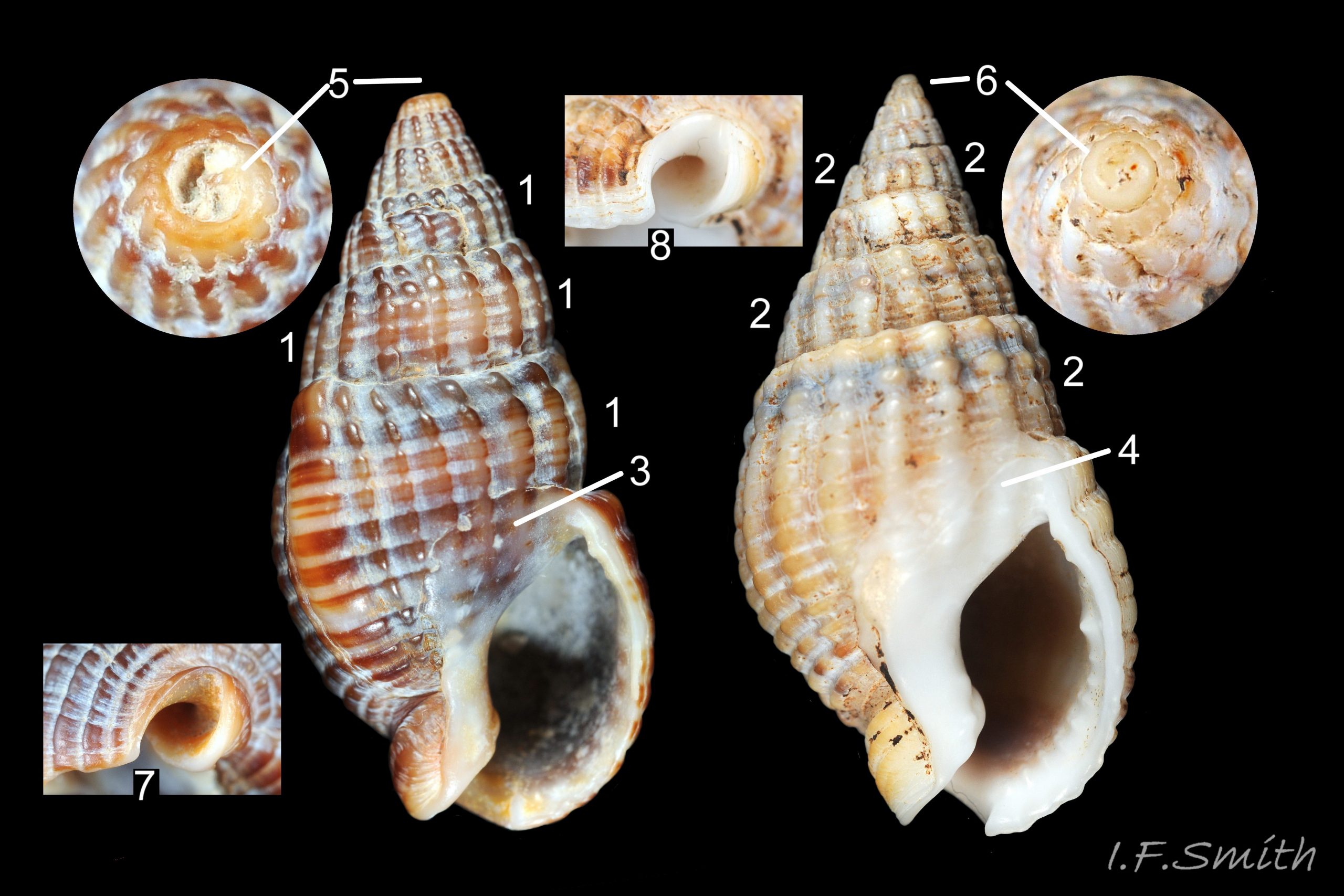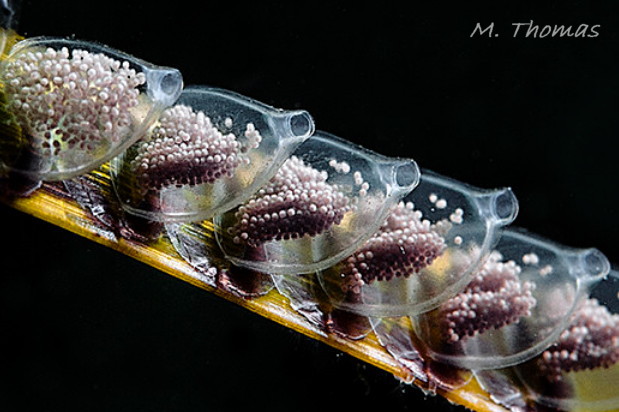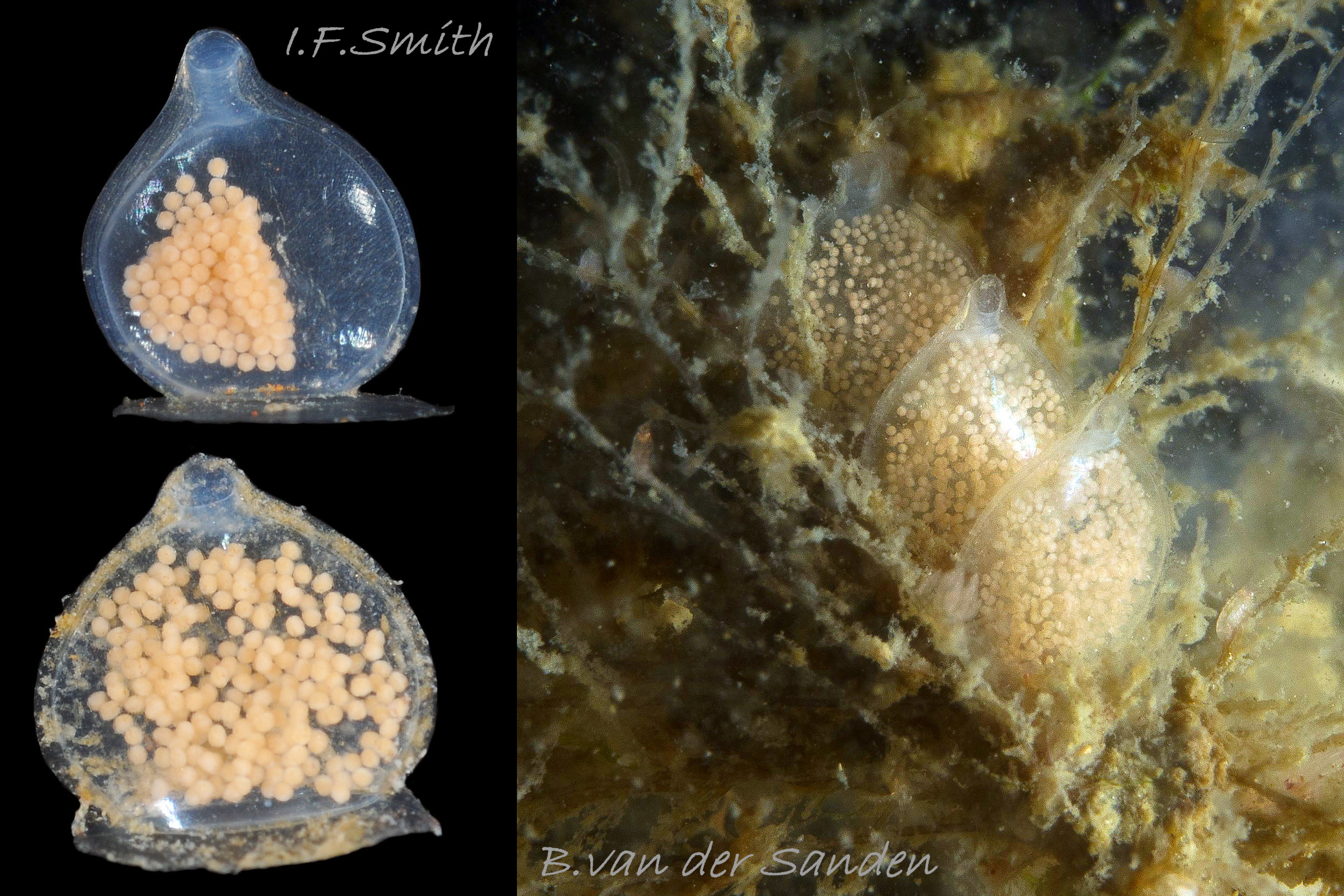Click image to enlarge with full caption. Main text below slider.
Recognition of Tritia nitida (Jeffreys, 1867) in Britain and Ireland.
Ian F. Smith (text) and Simon Taylor (fieldwork).
A pdf of this article can be downloaded from www.researchgate.net/publication/336441072_Recognition_of…
[Click ‘file available’ and then ‘download’.]
Odd numbers for T. nitida. Even numbers for T. reticulata sensu stricto (Linnaeus, 1758).
1: spire whorls convex. (Tumidity of T. nitida varies in Mediterranean.)
2: spire whorls almost flat.
3: translucent parietal lip exposes colour of underlying body whorl. (Occasionally opaque in Mediterranean.)
4: opaque white parietal lip, semicircular, conceals colour of body whorl.
5: protoconch eroded on this one and nearly all T. nitida in sample. (Generally eroded on live T. nitida in Ria de Vigo.)
6: protoconch intact. (Generally intact on T. reticulata in Ria de Vigo.)
7: siphonal canal meets palatal lip at obtuse angle (120° in this case).
8: siphonal canal meets palatal lip at acute or right angle (80° in this case).
(Angle on both species alters if eroded; fresh unworn shells required.)
Tritia nitida was first described by Jeffreys (1867) from the muddy estuaries of the Thames, Orwell and Roach rivers in Essex, south-east England. The Blackwater is a similar muddy estuary located between the Orwell and Roach. Jeffreys wrote, “I propose it as a distinct species with some misgiving; for, although I have not yet seen any intermediate form, it has not been ascertained that the two live together, and the present form seems to be peculiar to brackish water and mud.” In September 2019, S. T. collected a sample of 220 shells from the Blackwater. His find almost replicated Jeffreys’ experience as all accorded with his description, with the exception of a single typical T. reticulata (Linnaeus, 1758), shown in 01 Tritia nitida , which stood out as paler, having almost flat whorls, and being larger than all but four of the others (Jeffreys stated that those he found were smaller than T. reticulata). The exception diminishes Jeffreys’ misgiving about the two species not living together as it was in good condition, suggesting it had not been transported far and probably lived near the T. nitida.
Sympatric populations of the two species living in the Ria de Vigo, Spain, have been described in detail by Rolan and Luque (1994). Some of the differentiating features that they listed, and which are visible in , are listed above and have been labelled by odd numbers for T. nitida and even numbers for T. reticulata.
The World Register of Marine Species (WoRMS) accepts T. nitida as a valid species, supported by chromotology (Collyer, 1961), comparative morphology (Rolan & Luque, 1994), allozymes (Sanjuan et al., 1997) and DNA (Couceiro et al., 2012). There is widespread recognition of it by recorders in continental Europe and continental identification guides such as Trigo et al. (2018) but, strangely for a species first described by an Englishman with English specimens, virtually no recognition of it by recorders in Britain and Ireland. In 1895 in the Journal of Conchology, Marshall wrote;
“This is so obviously a variety of N. reticulata, that it has been tacitly ignored as a species as published in [Jeffreys, 1867] British Conchology. – – – the number of ribs [costae] in the type [N. reticulata] are exceedingly variable, being nearly twice as many in some specimens as in others.”
The numbers of costae vary within each species, and an overlap occurs between the species in southern Europe, but other morphological features and DNA separate them. No overlap in number of costae on the body whorl of non-juveniles was found in a comparison of T. nitida (10 to 14) from Essex with T. reticulata (15 to 23) from widespread sites in Britain (I.F.S. pers. obs.).
Marshall’s opinion has held sway in Britain and Ireland through Chaster et al. (1901), McClelland (1926), Winckworth (1932), and Turk (1973). Some publications mention it as a variety of T. reticulata. McMillan (1968), Fretter and Graham (1985) and Graham (1988) mention the possibility that it might be a separate species, but deal with it within the description of T. reticulata.
At the time of writing, NBN Atlas does not have a U.K. distribution map for T. nitida, but the UK Species Inventory, on which the NBN Atlas Species Dictionary is based, is to be altered to encapsulate the current concept of T. reticulata into a sensu lato concept for all the pre-split records and to create the two new concepts of T. reticulata sensu stricto (Linnaeus, 1758) and T. nitida (Jeffreys, 1867), (C. Raper, [the Natural History Museum] 2019, pers.comm. 27th September). There are no on-line available records of it in Ireland, but its distinctive egg capsules, in the proximity of adults, have been photographed in County Galway at Aughrus Pier and Killary Fjord ( 02 Tritia nitida ). T. nitida egg capsules have also been photographed in the Oosterschelde ( 03 Tritia nitida ) on the Dutch coast facing the Essex coast. All these sites are sheltered waters, like the Essex estuaries and Ria de Vigo.
The lack of recognition of T. nitida in Britain and Ireland has probably been perpetuated by the species account of T. reticulata [as Hinia reticulata] in Graham (1988), which is widely regarded as the standard British identification guide for shelled marine gastropods. T. reticulata is also described at greater length in its forerunner, Fretter and Graham, (1985). In both books, the same two specimens are illustrated. One from Harwich near the mouth of the Orwell Estuary, the type locality of T. nitida, captioned Hinia reticulata var. nitida is obviously T. nitida, though the lack of columellar or parietal tubercles often found on T. reticulata and absent from T. nitida is explained away by saying it is not fully mature, despite being 24mm high and near the maximum height of T. nitida from Essex. The other specimen illustrated, though not labelled var. nitida, is also T. nitida with convex whorls, no tubercles/teeth within either outer or inner lips and coming from Hellebaek on the low and variably saline Øresund, suited to the tolerant T. nitida. Egg capsules with the shape of those of T. nitida, drawn by G. Thorson who studied the marine invertebrates in the Øresund, are illustrated and labelled T. reticulata in Yonge and Thompson (1976).
Users of Graham (1988) with a specimen of T. nitida to identify will have found a close fit with the images purporting to be T. reticulata and almost certainly recorded it as such. Conversely, many, including I.F.S. will have been puzzled by the poor match of the illustrations when identifying typical flat-whorled T. reticulata specimens.
With the help of several contributors, an illustrated account is being created which will compare the two species in more detail. In the meantime, we hope this will raise awareness of the situation and prompt close examination of Tritia specimens, especially from sheltered waters such as the rias of south-west England. We have many specimens of beached T. nitida shells, but the colours are faded and most are partially eroded. We would be very grateful to receive recently live-collected T. nitida shells from Britain or Ireland for photography for the account. (We have generous contributions of live-collected shell images in standard postures from the Adriatic.)
Acknowledgements
We are most grateful to Mark Thomas and Bas van der Sanden for use of their images in this article.
Links and references
Chaster, G.W.; Knight, G.A.F.; Melvill, J.C. and Hoyle, W.E. 1901. List of British marine mollusca and brachiopoda. Manchester, Conchological Society of Great Britain and Ireland.
Collyer, D.M. 1961. Differences revealed by paper partition chromatography between the gastropod Nassarius reticulatus (L.) and specimens believed to be N. nitida (Jeffreys). J. Mar. Biol. Ass. 41(3): 683 to 693.
Couceiro, L., López, L., Sotka, E.E., Ruiz, J.M. & Barreiro, R. 2012. Molecular data delineate cryptic Nassarius species and characterize spatial genetic structure of N. nitidus. J. Mar. Biol. Ass. 92(5): 1175 to 1182.
Fretter, V. and Graham, A. 1985. The prosobranch molluscs of Britain and Denmark. Part 8 – Neogastropoda. Suppl. 15, J. Moll. Stud.
Graham, A. 1988. Molluscs: prosobranch and pyramidellid gastropods. Synopses of the British Fauna (New Series) no.2 (Second edition). Leiden, E.J.Brill/Dr. W. Backhuys. 662 pages.
Jeffreys, J.G. 1862-69. British conchology. vol. 4 (1867). London, van Voorst. (As Nassa reticulata) p346 in pdf archive.org/stream/britishconcholog04jeffr#page/346/mode/2up .
Original description of T. nitida (as Nassa nitida) on p349 at archive.org/stream/britishconcholog04jeffr#page/348/mode/2up
Marshall, J. T. 1895. Alterations in ‘British Conchology’. J. Conch. 8: 24 to 41.
www.biodiversitylibrary.org/item/99811#page/60/mode/1up [p38 as Nassa nitida]
McClelland, H. 1926. General index of all families, genera, species and varieties described and noted in the Journal of Conchology vols. I – XVI, 1874 to 1922. Proceedings of the Malacological Society of London vols. I – XV, 1893 to 1923. The Conchologist vols I – II, 1891 to 1893, continued as the Journal of Malacology vols. III – XII, 1894 to 1905. Birmingham, Birbeck and sons.
McMillan, N.F. 1968. British shells. London, F. Warn.
Rolan, E. and Luque, A.A. 1994. Nassarius reticulatus (Linnaeus, 1758) and Nassarius nitidus (Jeffreys, 1867) (Gastropoda, Nassariidae), dos especies válidas de los mares de
Europa. Iberus, 12 (2): 59-76.
Sanjuan, A., Pérez-Losada, M. & Rolan, E. 1997. Allozyme evidence for cryptic speciation in sympatric populations of Nassarius spp. (Mollusca: Gastropoda). J. Mar. Biol. Ass. 77(3): 773 to 784.
Thorson, G. 1946. Reproduction and larval development of Danish marine bottom invertebrates; with special reference to the planktonic larvae in the Sound (Øresund). Meddelelser fra Kommissionen for Danmarks Fiskeri- og Havundersøgelser. Serie Plankton. 4 (1): 1–523.
Trigo, J.E.; Diaz Agras, G.J.; Garcia Alvarez, O.L.; Guerra, A.; Moreira, J.; Pérez, J.; Rolán, E.; Troncoso, J.S,; Urgorri, V.. 2018. Guia de los Moluscos Marinos de Galicia. Servicio de Publicacións da Universidade de Vigo.
Yonge, C.M. and Thompson, T.E. 1976. Living marine molluscs. Collins, London. [Fig. 52G shows Danish egg capsules of T. nitida labelled as Nassarius reticulatus.]
Current taxonomy: World Register of Marine Species (WoRMS) www.marinespecies.org/aphia.php?p=taxdetails&id=890057



